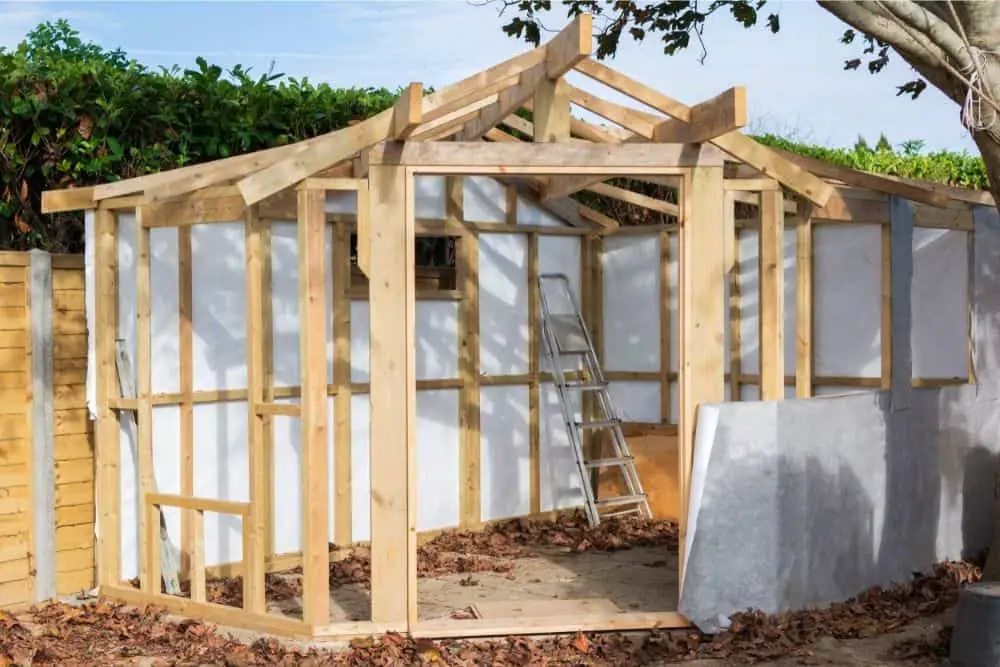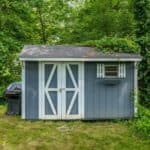Sheds are great for providing extra storage space for power tools, bikes, and more, or for converting into a ‘man cave’ or workshop.
However, when building a shed you need to be mindful of your neighbor’s property and land, after all, the last thing you want is to trigger a dispute by situating your shed too close to their fence or boundary.
In this article, we’ll be discussing the rules around building next to a neighbor’s fence, and the best place to situate your garden shed.

Planning permission
Generally speaking, most areas won’t require a building permit for a small shed, for example, one which measures 6×8 or an 8×10. However, most areas will only allow you to build sheds in your backyard, and larger sheds may challenge local zoning restrictions.
You should also check local regulations regarding the shed footprint, as some areas may not allow a shed to exceed a certain percentage of the lot size.
Violating local building regulations could see you faced with a penalty and the cost - and inconvenience - of relocating the shed or removing it.
When you might need a permit:
- If you want to install electricity in your shed, you will probably need a permit.
- You may also need a permit if you plan on using your shed to run your business or use it as a living space. In these instances, you usually need to let the local zoning department know as the structure will need to be properly permitted and inspected.
- In some areas, local codes also dictate how close a shed can be to fences, trees, property lines, and other buildings. In some places, you may not be allowed to attach a shed to your home, for example.
- There may also be size and height restrictions on building a shed, as well as certain requirements to fulfill regarding the shed foundation.
- If your home is regulated by a homeowner’s association (HOA) you’ll need to verify community rules and covenants before building your shed.
Can I build a shed next to my Neighbours fence?
This will depend on the area you live in, and it’s best to check with your HOA or municipality office.
In most instances, you can’t build a shed within 10 feet of the rear property line and 15 feet from a side property line, and you should always allow sufficient space between your shed, and your neighbor’s fence and yard.
If you build a shed too close to your neighbor’s fence, they may object for several reasons including:
- A loss of privacy or accessibility
- It could cause potential damage to the property
- There’s a valuable structure nearby
- It could ruin a public utility system
Regardless of whether or not you think your neighbor’s objections are valid, bear in mind that if you go ahead with building your shed without your neighbor’s consent, tensions could rise, not only between you and your current neighbors but with future ones too.
It’s definitely best to talk the shed through with the Local Planning Department and your neighbors, and consider any possible consequences.
Can I put a shed next to my boundary?
You can, but you should consider whether or not this boundary is shared, as if you have neighbors, this isn’t just your boundary. How close can I put a shed to my neighbor’s fence?
The closest you can build a shed to your neighbor’s fence to the side of your property is 15 feet, as these are the required rules in most areas. In terms of the rear property line, the closest you can put the shed is 10 feet.
You definitely don’t want to build a shed closer to the fence than stated in your local area’s building codes as it could cause issues with neighbors and the authorities.
The idea is that if you build too close to your neighbor’s property, you’re infringing upon their right to privacy. Situating a shed too close to your neighbor’s fence could trigger disputes over privacy and accessibility, and these are best avoided, if possible.
How far does a shed have to be from the fence?
Rules regarding the minimal space you need to leave between your shed and the fence vary depending on your state and municipality.
Some areas require at least 5 feet between the furthest edge of your shed and the fence, while others may state 10 or 15 feet as a minimum. It also depends on whether you’re building near the rear or side boundary.
There are other reasons why it’s generally recommended to leave space around the perimeter of your shed. Most experts recommend a space of at least 24 inches around the entirety of your shed, as this provides sufficient space for performing periodic repairs, and so forth.
It also gives you more flexibility with any future decisions you make regarding your shed.
Things to consider when building a shed
- Your first step should be to check the building codes and regulations in your area. Check with your chamber of commerce to find out what building codes need to be met, as these may affect where you can build the shed, how you design it and features such as the foundation. It’s much easier to check these before you start building, otherwise, you could be met with hefty fines and could even be required to remove the shed if it violates building codes.
- Once you’ve checked the regulations, you can now start planning your structure. Think about where you’ll place the shed, what it will look like, the materials you need, and how big it’ll be.
- Consider your neighbor’s fence and property. Most places have rules regarding building too close to a property boundary, and you need to ensure you leave sufficient space between the shed and your neighbor’s fence so that they’re able to maintain their privacy. Face it - you wouldn’t want someone building a shed right next to your fence.
- Consider any things that could impact your shed. For example, if your yard has a lot of trees, consider whether the branches pose a risk of falling and damaging the shed. Tree roots can also be problematic, and you may need to get these removed. Ensure the site is level and that it offers good drainage, otherwise you may get water sitting around your shed. Also think about what you will use the shed for, and whether its location is easily accessible.
- What will the finished shed look like? Consider how it will fit in with your garden and the rest of your property, and, if you’ll be using the shed as a workspace or a place for relaxation, consider features such as shutters, shelves, windows, and a decorative trim.
Final Verdict
Sheds offer a myriad of opportunities for additional space and storage, and the right shed can really enhance a property.
However, sheds can also go very wrong if you fail to be granted permission from your local authority, or if you upset your neighbors by building your structure too close to their fence.
Building a shed requires careful planning and consideration, and you should check building codes before you get started on the construction, otherwise, it could cost you in the long run if you have to pay a fine, relocate your shed, or even remove it altogether.









